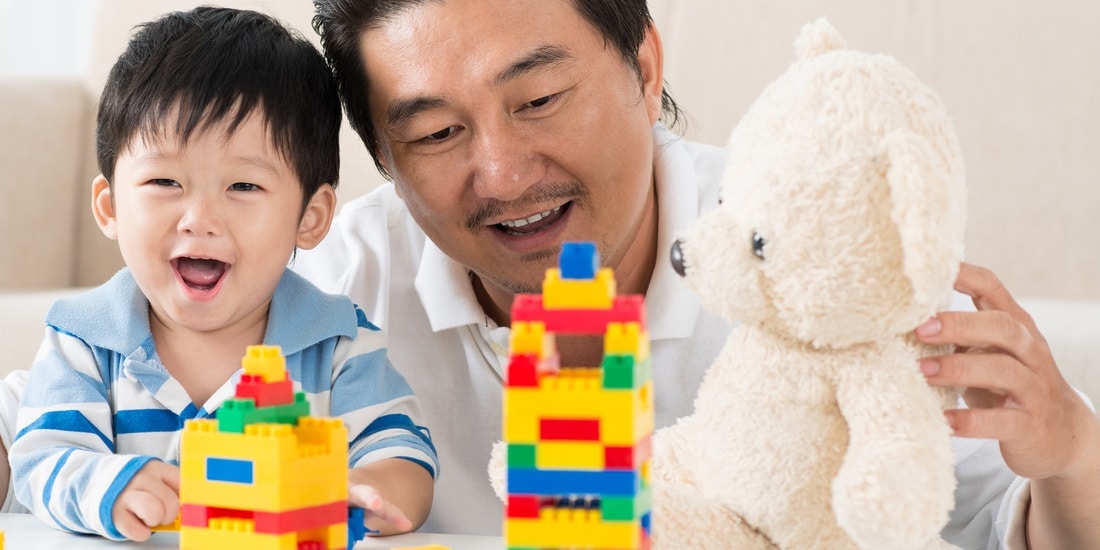Easy things you can do every day to encourage your toddler to use more language.
*Note – Suggestions in this article do not replace individualized professional intervention specific to your child’s needs. If you are concerned about your child’s communication development, seek a speech and language evaluation with a speech-language pathologist. Some services may be offered through public agencies. Be sure to consult your local resources. Learn more here.
Learn
A popular question. The good news is that there are easy things you can do on a daily basis.
Basic Concepts
- Meaningful, back-and-forth interactions are critical for language learning.
- Research proves that children learn more when actively engaged in a dialogue or interaction.
- Children do not learn language as well from passive language exposure.
So on a daily basis:
- Increase the frequency of back-and-forth interactions with your child.
- Reduce the amount of “passive” language-learning (e.g., screen time, talking in your child’s presence but not directly to them).
- Focus on how your child is actively receiving their words through engaging interactions (vs. on the number of words your child may know).
The more you use the same words and the same intonation with your voice during back-and-forth interactions, the more you will be priming your child to know what to say and what to do when they’re ready to use their own words.
Do
Techniques to Remember
Core Marbles
- Pause. Wait for your child to respond
- Reframe conversations
Pause. Wait for Your Child to Respond
- Pause – Create opportunities for your child to take their turn to speak. This means after you say something, after you ask a question, you p-a-u-s-e.
- It could be just 5 – 10 seconds, which may feel like an eternity to you, but for your child, it’ll give them just enough time to figure out what to say or do.
- The pause gives your child an important clue that it’s their turn to say something.
- Thinking time – wait time – is a technique commonly used among teachers and early childhood professionals.
- Stifle the urge to answer for your child or to ask the question another way if your child does not respond immediately. Be sure to wait and give your child ample time to try to respond and process what you said.
- If your child still doesn’t respond after some time, then go ahead and help them.
- Children with language delays need longer wait time and more repetition before speaking up.
Reframe Conversations
- Reframe how you think of a “conversation” – a conversation is simply two people taking turns in an interaction. For a two-year old, a “conversation” can be as simple as:
- “Peek-a….” –> “Boo!”
- “I love….” –> “You!”
- If your child is not speaking yet, their “turn” in the conversation may look a little different. They may not say any words, but can still take a “turn”:
- “Peek-a…” –> Child lifts blanket to reveal their face.
- “I love….” –> Child smiles and points to themself.
Fill-in-the-Blank Exercises (to stimulate conversation)
Ready, Set….
An easy and natural activity to do when something exciting is about to happen. For example:
- When your child is at the top of the slide, say, “Ready…set…” and pause (5 – 10 seconds) to see if your child will fill-in-the-blank and take their turn to say, “Go!”
- When you are about to blow bubbles, hold the bubble wand in front of your mouth and say, “Ready…set…” and pause (5 – 10 seconds) to see if your child will say, “Go!”
- If your child doesn’t say “Go”:
- Try giving your child the first sound as a hint, “G…”
- Blow the bubbles, and try again the next time you dip the bubble wand.
- If your child doesn’t say “Go”:
One, Two….
This is very similar to “Ready, Set, Go”. Remember to always pause and give your child plenty of time to respond.
I See A….
- Great to use when looking at books, playing with toys, outside (i.e., when there are external variables). For example:
- With a book – As you point to items that you want to label in the book, say, “I see a…” then point to a picture and pause (5 – 10 seconds) to see if your child will name the picture.
- If your child doesn’t name the picture, help them and do another one together.
- With a book – As you point to items that you want to label in the book, say, “I see a…” then point to a picture and pause (5 – 10 seconds) to see if your child will name the picture.
Shoes…on! Shoes…off!
When your child is getting dressed, create little speech routines around each article of clothing going on or coming off. For example:
- As you put a shirt on your child, say, “Shirt…” and pause (5 – 10 seconds), then fill in the word “on” if your child doesn’t respond.
- As you take off your child’s socks, say, “Socks…” and pause (5 – 10 seconds), before saying “off” if your child doesn’t respond.
